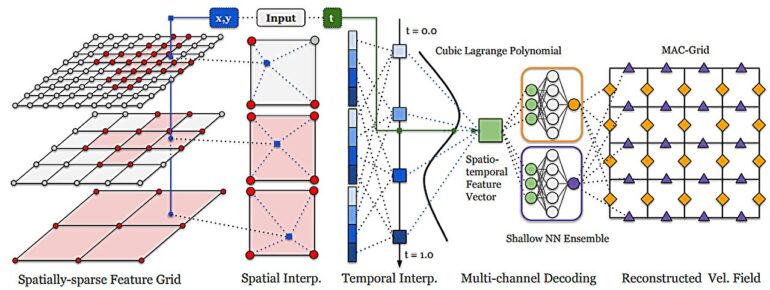- AI breakthrough enhances computer graphic simulations for accurate representation of natural phenomena.
- Georgia Tech researchers, led by Bo Zhu, blend machine learning models with traditional simulation methods.
- Award-winning paper introduces “Fluid Simulation on Neural Flow Maps,” setting a new benchmark.
- Neural flow maps, akin to neural radiance fields (NeRFs) in computer vision, promise to redefine simulation research.
- Traditional simulation pipelines face accuracy challenges; the proposed framework aligns AI capabilities with structural constraints.
- Zhu advocates for a symbiotic relationship between machine learning and traditional equations.
- Neural flow maps offer transformative possibilities for numerical simulation research across scientific disciplines.
Main AI News:
Cutting-edge advancements in artificial intelligence (AI) have revolutionized computer graphic simulations, enabling more precise representations of natural phenomena such as tornados, underwater scenes, vortices, and liquid foams.
Under the leadership of Georgia Tech Assistant Professor Bo Zhu and a collaborative team of researchers, computer graphic simulations have been elevated through the fusion of machine learning models and traditional simulation techniques. This pioneering work has resulted in enhanced simulations of various phenomena and sets a new benchmark for the field.
Zhu, along with his co-authors, unveiled their breakthrough in the paper titled “Fluid Simulation on Neural Flow Maps,” which received the prestigious Best Paper Award from the Association for Computing Machinery’s Special Interest Group in Computer Graphics and Interactive Technology (SIGGRAPH). Presented at the SIGGRAPH Asia conference in Sydney, Australia, the paper introduces a novel framework poised to transform the landscape of computer graphic simulations.
Published in ACM Transactions on Graphics, the paper heralds the advent of neural flow maps, offering a paradigm shift akin to the groundbreaking introduction of neural radiance fields (NeRFs) in computer vision. Just as NeRFs reshaped the field of computer vision by enabling the conversion of 2D images into immersive 3D environments, neural flow maps hold the potential to redefine simulation research in computer graphics.
Zhu emphasizes the transformative potential of AI in overcoming traditional limitations in simulation accuracy, echoing the monumental impact witnessed in natural language processing and computer vision domains. Traditional simulation pipelines, rooted in mathematical equations and numerical schemes, have long struggled to achieve the desired level of accuracy.
The core challenge lies in aligning the capabilities of AI algorithms with the structural constraints of conventional simulation pipelines. To address this, Zhu and his collaborators propose a groundbreaking framework that reimagines simulation pipelines, aptly named neural flow maps. These innovative pipelines leverage machine learning models to optimize the storage and processing of spatiotemporal data, surpassing the accuracy limitations of traditional approaches.
Crucially, Zhu emphasizes the complementary role of machine learning alongside traditional numerical equations, advocating for a symbiotic relationship that unlocks unprecedented research opportunities. Rather than replacing existing components, modern AI techniques are integrated synergistically with traditional pipelines to maximize their collective potential.
The implications of neural flow maps extend far beyond computer graphics, offering a new frontier for the integration of machine learning in numerical simulation research across diverse scientific disciplines. As the paper asserts, the success of neural flow maps heralds a transformative convergence of physics and machine learning, opening doors to previously unattainable algorithmic designs and research horizons.
In the words of Zhu, the success of neural flow maps represents a beacon of inspiration for the seamless integration of physics and machine learning, charting a course toward innovative advancements in computational sciences and beyond.
Conclusion:
The introduction of neural flow maps represents a pivotal moment in the evolution of computer graphics and simulation research. This transformative technology not only enhances the accuracy of simulations but also opens doors to new research opportunities across diverse scientific disciplines. Businesses operating in the computer graphics market should closely monitor developments in neural flow maps, as they have the potential to drive innovation and reshape industry standards. Embracing this cutting-edge technology can position companies at the forefront of computational sciences and unlock new avenues for growth and development.

